Tritone
In music theory, the tritone is defined as a musical interval spanning three adjacent whole tones (six semitones).[1] For instance, the interval from F up to the B above it (in short, F–B) is a tritone as it can be decomposed into the three adjacent whole tones F–G, G–A, and A–B.
| Inverse | tritone |
|---|---|
| Name | |
| Other names | augmented fourth, diminished fifth, the Devil’s interval (obscure) |
| Abbreviation | TT, A4, d5 |
| Size | |
| Semitones | 6 |
| Interval class | 6 |
| Just interval | Pythagorean: 729:512, 1024:729 5-limit: 25:18, 36:25; 45:32, 64:45 7-limit: 7:5, 10:7 13-limit: 13:9, 18:13 |
| Cents | |
| Equal temperament | 600 |
| Just intonation | Pythagorean: 612, 588 5-limit: 569, 631; 590, 610 7-limit: 583, 617 13-limit: 563, 637 |
Narrowly defined, each of these whole tones must be a step in the scale, so by this definition, within a diatonic scale there is only one tritone for each octave. For instance, the above-mentioned interval F–B is the only tritone formed from the notes of the C major scale. More broadly, a tritone is also commonly defined as any interval with a width of three whole tones (spanning six semitones in the chromatic scale), regardless of scale degrees. According to this definition, a diatonic scale contains two tritones for each octave. For instance, the above-mentioned C major scale contains the tritones F–B (from F to the B above it, also called augmented fourth) and B–F (from B to the F above it, also called diminished fifth, semidiapente, or semitritonus);[2] the latter is decomposed as a semitone B–C, a whole tone C–D, a whole tone D–E, and a semitone E–F, for a total width of three whole tones, but composed as four steps in the scale. In twelve-equal temperament, the tritone divides the octave exactly in half as 6 of 12 semitones or 600 of 1,200 cents.[3]
In classical music, the tritone is a harmonic and melodic dissonance and is important in the study of musical harmony. The tritone can be used to avoid traditional tonality: "Any tendency for a tonality to emerge may be avoided by introducing a note three whole tones distant from the key note of that tonality."[4] The tritone found in the dominant seventh chord can also drive the piece of music towards resolution with its tonic. These various uses exhibit the flexibility, ubiquity, and distinctness of the tritone in music.
The condition of having tritones is called tritonia; that of having no tritones is atritonia. A musical scale or chord containing tritones is called tritonic; one without tritones is atritonic.
Augmented fourth and diminished fifth
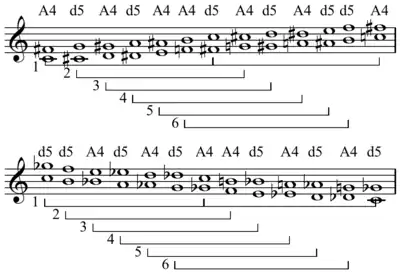

Since a chromatic scale is formed by 12 pitches (each a semitone apart from its neighbors), it contains 12 distinct tritones, each starting from a different pitch and spanning six semitones. According to a complex but widely used naming convention, six of them are classified as augmented fourths, and the other six as diminished fifths.
Under that convention, a fourth is an interval encompassing four staff positions, while a fifth encompasses five staff positions (see interval number for more details). The augmented fourth (A4) and diminished fifth (d5) are defined as the intervals produced by widening the perfect fourth and narrowing the perfect fifth by one chromatic semitone.[5] They both span six semitones, and they are the inverse of each other, meaning that their sum is exactly equal to one perfect octave (A4 + d5 = P8). In twelve-tone equal temperament, the most commonly used tuning system, the A4 is equivalent to a d5, as both have the size of exactly half an octave. In most other tuning systems, they are not equivalent, and neither is exactly equal to half an octave.
Any augmented fourth can be decomposed into three whole tones. For instance, the interval F–B is an augmented fourth and can be decomposed into the three adjacent whole tones F–G, G–A, and A–B.
It is not possible to decompose a diminished fifth into three adjacent whole tones. The reason is that a whole tone is a major second, and according to a rule explained elsewhere, the composition of three seconds is always a fourth (for instance, an A4). To obtain a fifth (for instance, a d5), it is necessary to add another second. For instance, using the notes of the C major scale, the diminished fifth B–F can be decomposed into the four adjacent intervals
- B–C (minor second), C–D (major second), D–E (major second), and E–F (minor second).
Using the notes of a chromatic scale, B–F may be also decomposed into the four adjacent intervals
- B–C♯ (major second), C♯–D♯ (major second), D♯–E♯ (major second), and E♯–F♮ (diminished second).
Notice that the last diminished second is formed by two enharmonically equivalent notes (E♯ and F♮). On a piano keyboard, these notes are produced by the same key. However, in the above-mentioned naming convention, they are considered different notes, as they are written on different staff positions and have different diatonic functions within music theory.
Definitions
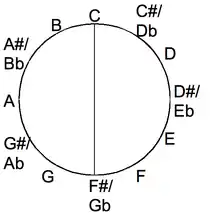
A tritone (abbreviation: TT) is traditionally defined as a musical interval composed of three whole tones. As the symbol for whole tone is T, this definition may also be written as follows:
- TT = T+T+T
Only if the three tones are of the same size (which is not the case for many tuning systems) can this formula be simplified to:
- TT = 3T
This definition, however, has two different interpretations (broad and strict).
Broad interpretation (chromatic scale)
In a chromatic scale, the interval between any note and the previous or next is a semitone. Using the notes of a chromatic scale, each tone can be divided into two semitones:
- T = S+S
For instance, the tone from C to D (in short, C–D) can be decomposed into the two semitones C–C♯ and C♯–D by using the note C♯, which in a chromatic scale lies between C and D. This means that, when a chromatic scale is used, a tritone can be also defined as any musical interval spanning six semitones:
- TT = T+T+T = S+S+S+S+S+S.
According to this definition, with the twelve notes of a chromatic scale it is possible to define twelve different tritones, each starting from a different note and ending six notes above it. Although all of them span six semitones, six of them are classified as augmented fourths, and the other six as diminished fifths.
Strict interpretation (diatonic scale)
Within a diatonic scale, whole tones are always formed by adjacent notes (such as C and D) and therefore they are regarded as incomposite intervals. In other words, they cannot be divided into smaller intervals. Consequently, in this context the above-mentioned "decomposition" of the tritone into six semitones is typically not allowed.
If a diatonic scale is used, with its 7 notes it is possible to form only one sequence of three adjacent whole tones (T+T+T). This interval is an A4. For instance, in the C major diatonic scale (C–D–E–F–G–A–B–...), the only tritone is from F to B. It is a tritone because F–G, G–A, and A–B are three adjacent whole tones. It is a fourth because the notes from F to B are four (F, G, A, B). It is augmented (i.e., widened) because it is wider than most of the fourths found in the scale (they are perfect fourths).
According to this interpretation, the d5 is not a tritone. Indeed, in a diatonic scale, there is only one d5, and this interval does not meet the strict definition of tritone, as it is formed by one semitone, two whole tones, and another semitone:
- d5 = S+T+T+S.
For instance, in the C major diatonic scale, the only d5 is from B to F. It is a fifth because the notes from B to F are five (B, C, D, E, F). It is diminished (i.e. narrowed) because it is smaller than most of the fifths found in the scale (they are perfect fifths).
Size in different tuning systems

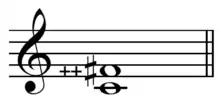
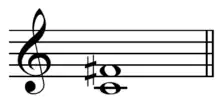



In twelve-tone equal temperament, the A4 is exactly half an octave (i.e., a ratio of √2:1 or 600 cents. The inverse of 600 cents is 600 cents. Thus, in this tuning system, the A4 and its inverse (d5) are equivalent.
The half-octave or equal tempered A4 and d5 are unique in being equal to their own inverse (each to the other). In other meantone tuning systems, besides 12-tone equal temperament, A4 and d5 are distinct intervals because neither is exactly half an octave. In any meantone tuning near to 2⁄9-comma meantone the A4 is near to the ratio 7:5 (582.51) and the d5 to 10:7 (617.49), which is what these intervals are in septimal meantone temperament. In 31 equal temperament, for example, the A4 is 580.65 cents, whereas the d5 is 619.35 cents. This is perceptually indistinguishable from septimal meantone temperament.
Since they are the inverse of each other, by definition A4 and d5 always add up to exactly one perfect octave:
- A4 + d5 = P8.
On the other hand, two A4 add up to six whole tones. In equal temperament, this is equal to exactly one perfect octave:
- A4 + A4 = P8.
In quarter-comma meantone temperament, this is a diesis (128:125) less than a perfect octave:
- A4 + A4 = P8 − diesis.
In just intonation several different sizes can be chosen both for the A4 and the d5. For instance, in 5-limit tuning, the A4 is either 45:32[7][8][9] or 25:18,[10] and the d5 is either 64:45 or 36:25.[11] The 64:45 just diminished fifth arises in the C major scale between B and F, consequently the 45:32 augmented fourth arises between F and B.[12]
These ratios are not in all contexts regarded as strictly just but they are the justest possible in 5-limit tuning. 7-limit tuning allows for the justest possible ratios (ratios with the smallest numerator and denominator), namely 7:5 for the A4 (about 582.5 cents, also known as septimal tritone) and 10:7 for the d5 (about 617.5 cents, also known as Euler's tritone).[7][13][14] These ratios are more consonant than 17:12 (about 603.0 cents) and 24:17 (about 597.0 cents), which can be obtained in 17-limit tuning, yet the latter are also fairly common, as they are closer to the equal-tempered value of 600 cents.
Eleventh harmonic
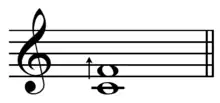
The ratio of the eleventh harmonic, 11:8 (551.318 cents; approximated as F![]() 4 above C1), known as the lesser undecimal tritone or undecimal semi-augmented fourth, is found in some just tunings and on many instruments. For example, very long alphorns may reach the twelfth harmonic and transcriptions of their music usually show the eleventh harmonic sharp (F♯ above C, for example), as in Brahms's First Symphony.[15] This note is often corrected to 4:3 on the natural horn in just intonation or Pythagorean tunings, but the pure eleventh harmonic was used in pieces including Britten's Serenade for tenor, horn and strings.[16] Ivan Wyschnegradsky considered the major fourth a good approximation of the eleventh harmonic.
4 above C1), known as the lesser undecimal tritone or undecimal semi-augmented fourth, is found in some just tunings and on many instruments. For example, very long alphorns may reach the twelfth harmonic and transcriptions of their music usually show the eleventh harmonic sharp (F♯ above C, for example), as in Brahms's First Symphony.[15] This note is often corrected to 4:3 on the natural horn in just intonation or Pythagorean tunings, but the pure eleventh harmonic was used in pieces including Britten's Serenade for tenor, horn and strings.[16] Ivan Wyschnegradsky considered the major fourth a good approximation of the eleventh harmonic.

Dissonance and expressiveness
Ján Haluska wrote:
The unstable character of the tritone sets it apart, as discussed in [Paul Hindemith. The Craft of Musical Composition, Book I. Associated Music Publishers, New York, 1945]. It can be expressed as a ratio by compounding suitable superparticular ratios. Whether it is assigned the ratio 64/45 or 45/32, depending on the musical context, or indeed some other ratio, it is not superparticular, which is in keeping with its unique role in music.[17]
Harry Partch has written:
Although this ratio [45/32] is composed of numbers which are multiples of 5 or under, they are excessively large for a 5-limit scale, and are sufficient justification, either in this form or as the tempered "tritone", for the epithet "diabolic", which has been used to characterize the interval. This is a case where, because of the largeness of the numbers, none but a temperament-perverted ear could possibly prefer 45/32 to a small-number interval of about the same width.
In the Pythagorean ratio 81/64 both numbers are multiples of 3 or under, yet because of their excessive largeness the ear certainly prefers 5/4 for this approximate degree, even though it involves a prime number higher than 3. In the case of the 45/32 "tritone" our theorists have gone around their elbows to reach their thumbs, which could have been reached simply and directly and non-"diabolically" via the number 7....[18]
Common uses
Occurrences in diatonic scales
The augmented fourth (A4) occurs naturally between the fourth and seventh scale degrees of the major scale (for example, from F to B in the key of C major). It is also present in the natural minor scale as the interval formed between the second and sixth scale degrees (for example, from D to A♭ in the key of C minor). The melodic minor scale, having two forms, presents a tritone in different locations when ascending and descending (when the scale ascends, the tritone appears between the third and sixth scale degrees and the fourth and seventh scale degrees, and when the scale descends, the tritone appears between the second and sixth scale degrees). Supertonic chords using the notes from the natural minor mode thus contain a tritone, regardless of inversion. Containing tritones, these scales are tritonic.
Occurrences in chords
The dominant seventh chord in root position contains a diminished fifth (tritone) within its pitch construction: it occurs between the third and seventh above the root. In addition, augmented sixth chords, some of which are enharmonic to dominant seventh chords, contain tritones spelled as augmented fourths (for example, the German sixth, from A to D♯ in the key of A minor); the French sixth chord can be viewed as a superposition of two tritones a major second apart.
The diminished triad also contains a tritone in its construction, deriving its name from the diminished-fifth interval (i.e. a tritone). The half-diminished seventh chord contains the same tritone, while the fully diminished seventh chord is made up of two superposed tritones a minor third apart.
Other chords built on these, such as ninth chords, often include tritones (as diminished fifths).
Resolution

In all of the sonorities mentioned above, used in functional harmonic analysis, the tritone pushes towards resolution, generally resolving by step in contrary motion. This determines the resolution of chords containing tritones.
The augmented fourth resolves outward to a minor or major sixth (the first measure below). The inversion of this, a diminished fifth, resolves inward to a major or minor third (the second measure below). The diminished fifth is often called a tritone in modern tonal theory, but functionally and notationally it can only resolve inwards as a diminished fifth and is therefore not reckoned a tritone—that is, an interval composed of three adjacent whole tones—in mid-renaissance (early 16th-century) music theory.[19]
Other uses
The tritone is also one of the defining features of the Locrian mode, being featured between the ![]() and fifth scale degrees.
and fifth scale degrees.
The half-octave tritone interval is used in the musical/auditory illusion known as the tritone paradox.
Historical uses

The tritone is a restless interval, classed as a dissonance in Western music from the early Middle Ages through to the end of the common practice period. This interval was frequently avoided in medieval ecclesiastical singing because of its dissonant quality. The first explicit prohibition of it seems to occur with the development of Guido of Arezzo's hexachordal system, who suggested that rather than make B♭ a diatonic note, the hexachord be moved and based on C to avoid the F–B tritone altogether. Later theorists such as Ugolino d'Orvieto and Tinctoris advocated the inclusion of B♭.[20]
From then until the end of the Renaissance the tritone was regarded as an unstable interval and rejected as a consonance by most theorists.[21]
The name diabolus in musica (Latin for 'the Devil in music') has been applied to the interval from at least the early 18th century, or the late Middle Ages,[22] though its use is not restricted to the tritone, being that the original found example of the term "diabolus en musica" is "Mi Contra Fa est diabolus en musica" (Mi against Fa is the devil in music). Andreas Werckmeister cites this term in 1702 as being used by "the old authorities" for both the tritone and for the clash between chromatically related tones such as F♮ and F♯,[23] and five years later likewise calls "diabolus in musica" the opposition of "square" and "round" B (B♮ and B♭, respectively) because these notes represent the juxtaposition of "mi contra fa".[24] Johann Joseph Fux cites the phrase in his seminal 1725 work Gradus ad Parnassum, Georg Philipp Telemann in 1733 describes, "mi against fa", which the ancients called "Satan in music"—and Johann Mattheson, in 1739, writes that the "older singers with solmization called this pleasant interval 'mi contra fa' or 'the devil in music'."[25] Although the latter two of these authors cite the association with the devil as from the past, there are no known citations of this term from the Middle Ages, as is commonly asserted.[26] However Denis Arnold, in the New Oxford Companion to Music, suggests that the nickname was already applied early in the medieval music itself:
It seems first to have been designated as a "dangerous" interval when Guido of Arezzo developed his system of hexachords and with the introduction of B flat as a diatonic note, at much the same time acquiring its nickname of "Diabolus in Musica" ("the devil in music").[27]
That original symbolic association with the devil and its avoidance led to Western cultural convention seeing the tritone as suggesting "evil" in music. However, stories that singers were excommunicated or otherwise punished by the Church for invoking this interval are likely fanciful. At any rate, avoidance of the interval for musical reasons has a long history, stretching back to the parallel organum of the Musica Enchiriadis. In all these expressions, including the commonly cited "mi contra fa est diabolus in musica", the "mi" and "fa" refer to notes from two adjacent hexachords. For instance, in the tritone B–F, B would be "mi", that is the third scale degree in the "hard" hexachord beginning on G, while F would be "fa", that is the fourth scale degree in the "natural" hexachord beginning on C.
Later, with the rise of the Baroque and Classical music era, composers accepted the tritone, but used it in a specific, controlled way—notably through the principle of the tension-release mechanism of the tonal system. In that system (which is the fundamental musical grammar of Baroque and Classical music), the tritone is one of the defining intervals of the dominant-seventh chord and two tritones separated by a minor third give the fully diminished seventh chord its characteristic sound. In minor, the diminished triad (comprising two minor thirds, which together add up to a tritone) appears on the second scale degree—and thus features prominently in the progression iio–V–i. Often, the inversion iio6 is used to move the tritone to the inner voices as this allows for stepwise motion in the bass to the dominant root. In three-part counterpoint, free use of the diminished triad in first inversion is permitted, as this eliminates the tritone relation to the bass.[28]
It is only with the Romantic music and modern classical music that composers started to use it totally freely, without functional limitations notably in an expressive way to exploit the "evil" connotations culturally associated with it, such as Franz Liszt's use of the tritone to suggest Hell in his Dante Sonata:

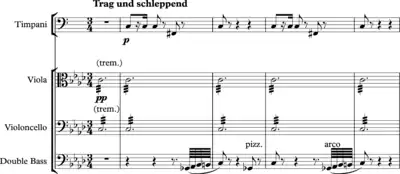
—or Wagner's use of timpani tuned to C and F♯ to convey a brooding atmosphere at the start of the second act of the opera Siegfried.
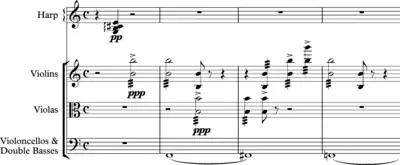
In his early cantata La Damoiselle élue, Debussy uses a tritone to convey the words of the poem by Dante Gabriel Rossetti.
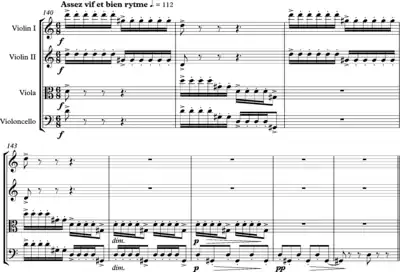
bars 140–147.
Roger Nichols (1972, p19) says that "the bare fourths, the wide spacing, the tremolos, all depict the words—'the light thrilled towards her'—with sudden, overwhelming power."[29] Debussy's String Quartet also features passages that emphasize the tritone.
The tritone was also exploited heavily in that period as an interval of modulation for its ability to evoke a strong reaction by moving quickly to distantly related keys. For example, the climax of Hector Berlioz's La damnation de Faust (1846) consists of a transition between "huge B and F chords" as Faust arrives in Pandaemonium, the capital of Hell.[30] Musicologist Julian Rushton calls this "a tonal wrench by a tritone".[31]
Later, in twelve-tone music, serialism, and other 20th century compositional idioms, composers considered it a neutral interval.[32] In some analyses of the works of 20th century composers, the tritone plays an important structural role; perhaps the most cited is the axis system, proposed by Ernő Lendvai, in his analysis of the use of tonality in the music of Béla Bartók.[33] Tritone relations are also important in the music of George Crumb and Benjamin Britten, whose War Requiem features a tritone between C and F♯ as a recurring motif.[34] John Bridcut (2010, p. 271) describes the power of the interval in creating the sombre and ambiguous opening of the War Requiem:[35] "The idea that the chorus and orchestra are confident in their wrong-headed piety is repeatedly disputed by the music. From the instability of the opening tritone—that unsettling interval between C and F sharp—accompanied by the tolling of warning bells ... eventually resolves into a major chord for the arrival of the boys singing 'Te decet hymnus'."[36] Leonard Bernstein uses the tritone harmony as a basis for much of West Side Story.[37][38] George Harrison uses tritones on the downbeats of the opening phrases of the Beatles songs "The Inner Light", "Blue Jay Way" and "Within You Without You", creating a prolonged sense of suspended resolution.[39] Perhaps the most striking use of the interval in rock music of the late 1960s can be found in Jimi Hendrix's song "Purple Haze". According to Dave Moskowitz (2010, p. 12), Hendrix "ripped into 'Purple Haze' by beginning the song with the sinister sounding tritone interval creating an opening dissonance, long described as 'The Devil in Music'."[40] The opening riff of "Black Sabbath", the first song on Black Sabbath's eponymous debut album, is an inversion of a tritone;[41] the album, and this song in particular, are considered to mark the birth of heavy metal music.[42]
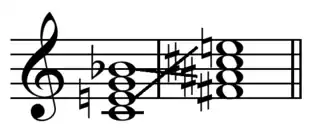
Tritones also became important in the development of jazz tertian harmony, where triads and seventh chords are often expanded to become 9th, 11th, or 13th chords, and the tritone often occurs as a substitute for the naturally occurring interval of the perfect 11th. Since the perfect 11th (i.e. an octave plus perfect fourth) is typically perceived as a dissonance requiring a resolution to a major or minor 10th, chords that expand to the 11th or beyond typically raise the 11th a semitone (thus giving us an augmented or sharp 11th, or an octave plus a tritone from the root of the chord) and present it in conjunction with the perfect 5th of the chord. Also in jazz harmony, the tritone is both part of the dominant chord and its substitute dominant (also known as the sub V chord). Because they share the same tritone, they are possible substitutes for one another. This is known as a tritone substitution. The tritone substitution is one of the most common chord and improvisation devices in jazz.
In the theory of harmony it is known that a diminished interval needs to be resolved inwards, and an augmented interval outwards. ... and with the correct resolution of the true tritones this desire is totally satisfied. However, if one plays a just diminished fifth that is perfectly in tune, for example, there is no wish to resolve it to a major third. Just the opposite—aurally one wants to enlarge it to a minor sixth. The opposite holds true for the just augmented fourth. ...
These apparently contradictory aural experiences become understandable when the cents of both types of just tritones are compared with those of the true tritones and then read 'crossed-over'. One then notices that the just augmented fourth of 590.224 cents is only 2 cents bigger than the true diminished fifth of 588.270 cents, and that both intervals lie below the middle of the octave of 600.000 cents. It is no wonder that, following the ear, we want to resolve both downwards. The ear only desires the tritone to be resolved upwards when it is bigger than the middle of the octave. Therefore the opposite is the case with the just diminished fifth of 609.776 cents.[8]
See also
References
- Drabkin, William (20 January 2001). "Tritone". Oxford Music Online. doi:10.1093/gmo/9781561592630.article.28403. ISBN 978-1-56159-263-0. Retrieved August 31, 2020.
- E.g., Jacobus Leodiensis, Speculum musicae, Liber secundus, in Jacobi Leodiensis Speculum musicae, edited by Roger Bragard, Corpus Scriptorum de Musica 3/2 ([Rome]: American Institute of Musicology, 1961): 128–31, citations on 192–96, 200, and 229; Jacobus Leodiensis, Speculum musicae, Liber sextus, in Jacobi Leodiensis Speculum musicae, edited by Roger Bragard, Corpus Scriptorum de Musica 3/6 ([Rome]: American Institute of Musicology, 1973): 1–161, citations on 52 and 68; Johannes Torkesey, Declaratio et expositio, London: British Library, Lansdowne MS 763, ff.89v-94v, citations on f.92r,2–3; Prosdocimus de Beldemandis, Tractatus musice speculative, in D. Raffaello Baralli and Luigi Torri, "Il Trattato di Prosdocimo de' Beldomandi contro il Lucidario di Marchetto da Padova per la prima volta trascritto e illustrato", Rivista Musicale Italiana 20 (1913): 731–62, citations on 732–34.
- Randel (2003), p. 911. "A prominent element in the whole-tone scale...its symmetry with respect to the octave gives it a special role in twelve-tone music as well."
- Smith Brindle, Reginald (1966). Serial Composition. Oxford University Press. p. 66. ISBN 0-19-311906-4.
- Bruce Benward & Marilyn Nadine Saker (2003). Music: In Theory and Practice, Vol. I, seventh edition (Boston: McGraw-Hill), p. 54. ISBN 978-0-07-294262-0.
- Fonville, John (1991). "Ben Johnston's Extended Just Intonation: A Guide for Interpreters". Perspectives of New Music. 29 (2): 106–137. doi:10.2307/833435. JSTOR 833435.
- Partch, Harry. (1979 [1974]). Genesis of a Music: An Account of a Creative Work, Its Roots and Its Fulfillments, 2nd ed. (New York: Da Capo Press): p. 69. ISBN 0-306-80106-X (pbk). https://pearl-hifi.com/06_Lit_Archive/02_PEARL_Arch/Vol_16/Sec_51/4555_Genesis_of_a_Music_2nd_Edn.pdf. Retrieved July 22, 2021
- Renold, Maria (2004). Intervals, Scales, Tones and the Concert Pitch C=128Hz, translated from the German by Bevis Stevens, with additional editing by Anna R. Meuss (Forest Row: Temple Lodge): p. 15–16. ISBN 1-902636-46-5.
- Helmholtz, Hermann von (2005). On the Sensations of Tone as a Physiological Basis for the Theory of Music, p. 457. ISBN 1-4191-7893-8. "Cents in interval: 590, Name of Interval: Just Tritone, Number to an Octave: 2.0. Cents in interval: 612, Name of Interval: Pyth. Tritone, Number to an Octave: 2.0."
- Haluska , Ján (2003), The Mathematical Theory of Tone Systems, Pure and Applied Mathematics Series 262 (New York: Marcel Dekker; London: Momenta), p. xxiv. ISBN 0-8247-4714-3. "25:18 classic augmented fourth".
- Haluska (2003), p. xxv. "36/25 classic diminished fifth".
- Paul, Oscar (1885). A manual of harmony for use in music-schools and seminaries and for self-instruction, p. 165. Theodore Baker, trans. G. Schirmer.
- Haluska (2003). p. xxiii. "7:5 septimal or Huygens' tritone, Bohlen-Pierce fourth", "10:7 Euler's tritone".
- Strange, Patricia and Patricia, Allen (2001). The contemporary violin: Extended performance techniques, p. 147. ISBN 0-520-22409-4. "...septimal tritone, 10:7; smaller septimal tritone, 7:5;...This list is not exhaustive, even when limited to the first sixteen partials. Consider the very narrow augmented fourth, 13:9....just intonation is not an attempt to generate necessarily consonant intervals."
- Monelle, Raymond (2006). The Musical Topic: Hunt, Military And Pastoral, p. 102. ISBN 9780253347664.
- Fauvel, John; Flood, Raymond; and Wilson, Robin J. (2006). Music And Mathematics, pp. 21–22. ISBN 9780199298938.
- Haluska (2003), p. 286.
- Partch (1974), p. 115.
- Bent, Margaret (1994). "Accidentals, Counterpoint and Notation in Aaron's Aggiunta to the Toscanello in Musica". Journal of Musicology. 12 (3): 306–344 [308]. doi:10.2307/764089. JSTOR 764089.
- Guido d'Arezzo, Epistola de ignoto cantu, lines 309–322
- Drabkin, William. "Tritone". Grove Music Online (subscription access). Oxford Music Online. Retrieved 2008-07-21.
- Randel (2003), p.239.
- Andreas Werckmeister. Harmonologia musica, oder kurze Anleitung zur musicalischen Composition (Frankfurt and Leipzig: Theodor Philipp Calvisius 1702): 6.
- Andreas Werckmeister, Musicalische Paradoxal-Discourse, oder allgemeine Vorstellungen (Quedlinburg: Theodor Philipp Calvisius, 1707): 75–76.
- Reinhold, Hammerstein (1974). Diabolus in musica: Studien zur Ikonographie der Musik im Mittelalter. Neue Heidelberger Studien zur Musikwissenschaft (in German). Vol. 6. Bern: Francke. p. 7. OCLC 1390982.
... mi contra fa ... welches die alten den Satan in der Music nenneten ... alten Solmisatores dieses angenehme Intervall mi contra fa oder den Teufel in der Music genannt haben.
- Smith, F. J. (1979). "Some aspects of the tritone and the semitritone in the Speculum Musicae: the non‐emergence of the diabolus in musica". Journal of Musicological Research. 3 (1–2): 63–74 [70]. doi:10.1080/01411897908574507.
- Arnold, Denis (1983). "Tritone". in The New Oxford Companion to Music, Volume 1: A–J, Oxford University Press. ISBN 0-19-311316-3
- Jeppesen, Knud (1992) [1939]. Counterpoint: the polyphonic vocal style of the sixteenth century. Translated by Haydon, Glen. foreword by Alfred Mann. New York: Dover. ISBN 0-486-27036-X.
- Nichols, R. (1972). Debussy. Oxford University Press.
- Rushton, Julian (1983). The Musical Language of Berlioz. Cambridge University Press. p. 254.
- Rushton, Julian (2001). The Music of Berlioz. Oxford University Press.
- Persichetti, Vincent (1961). Twentieth-century Harmony: Creative Aspects and Practice. New York: W. W. Norton. ISBN 0-393-09539-8. OCLC 398434.
- Lendvai, Ernő (1971). Béla Bartók: An Analysis of his Music. introd. by Alan Bush. London: Kahn & Averill. pp. 1–16. ISBN 0-900707-04-6. OCLC 240301.
- "Musical Analysis of the War Requiem". Retrieved 16 March 2016.
- "Britten: War Requiem". YouTube.
- Bridcut, J. (2010), Essential Britten, a pocket guide for the Britten Centenary. London, Faber.
- Kogan, Judith (2017-10-31). "The Unsettling Sound Of Tritones, The Devil's Interval". NPR. Retrieved 2021-11-11.
- Rizzi, Sofia (2019-03-04). "Why did Bernstein build West Side Story around 'The Devil's Interval'?". Classic FM. Retrieved 2021-11-11.
- Dominic Pedler. The Songwriting Secrets of the Beatles. Music Sales Ltd. Omnibus Press. London, 2010 pp. 522–523
- Moskowitz, D. (2010). The Words and Music of Jimi Hendrix. Praeger.
- Chesna, James (26 February 2010). "'Sleeping (In the Fire)': Listening Room fearless leader faces down fear". WJRT-TV/DT. Archived from the original on 29 June 2011. Retrieved 28 February 2010.
- William Irwin, Black Sabbath and Philosophy: Mastering Reality (Hoboken: Wiley-Blackwell, 2012), ISBN 978-1118397596
Further reading
- R., Ken (2012). DOG EAR Tritone Substitution for Jazz Guitar, Amazon Digital Services, Inc., ASIN: B008FRWNIW